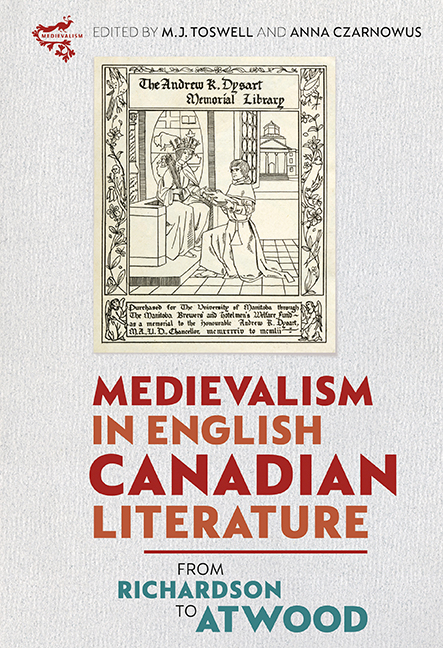Book contents
- Frontmatter
- Contents
- Introduction: English Canadian Medievalism
- 1 “Men of the North”: Archibald Lampman's Use of Incidents in the Lives of Medieval Monarchs and Aristocrats
- 2 “Going Back to the Middle Ages”: Tracing Medievalism in Julia Beckwith Hart's St. Ursula's Convent and John Richardson's Wacousta
- 3 John Richardson's Wacousta and the Transfer of Medievalist Romance
- 4 A Canadian Caliban in King Arthur's Court: Materialist Medievalism and Northern Gothic in William Wilfred Campbell's Mordred
- 5 Orientalist Medievalism in Early Canadian Periodicals
- 6 The Collegiate Gothic: Legitimacy and Inheritance in Robertson Davies's The Rebel Angels
- 7 Earle Birney as Public Poet: a Canadian Chaucer?
- 8 “That's what you get for being food”: Margaret Atwood's Symbolic Cannibalism 129
- 9 Lost in Allegory: Grief and Chivalry in Kit Pearson's A Perfect, Gentle Knight
- 10 Remembering the Romance: Medievalist Romance in Fantasy Fiction by Guy Gavriel Kay and Charles de Lint
- 11 Medievalisms and Romance Traditions in Guy Gavriel Kay's Ysabel
- 12 The Medieval Methods of Patrick DeWitt: Undermajordomo Minor
- Index
- Miscellaneous Endmatter
Introduction: English Canadian Medievalism
Published online by Cambridge University Press: 25 March 2020
- Frontmatter
- Contents
- Introduction: English Canadian Medievalism
- 1 “Men of the North”: Archibald Lampman's Use of Incidents in the Lives of Medieval Monarchs and Aristocrats
- 2 “Going Back to the Middle Ages”: Tracing Medievalism in Julia Beckwith Hart's St. Ursula's Convent and John Richardson's Wacousta
- 3 John Richardson's Wacousta and the Transfer of Medievalist Romance
- 4 A Canadian Caliban in King Arthur's Court: Materialist Medievalism and Northern Gothic in William Wilfred Campbell's Mordred
- 5 Orientalist Medievalism in Early Canadian Periodicals
- 6 The Collegiate Gothic: Legitimacy and Inheritance in Robertson Davies's The Rebel Angels
- 7 Earle Birney as Public Poet: a Canadian Chaucer?
- 8 “That's what you get for being food”: Margaret Atwood's Symbolic Cannibalism 129
- 9 Lost in Allegory: Grief and Chivalry in Kit Pearson's A Perfect, Gentle Knight
- 10 Remembering the Romance: Medievalist Romance in Fantasy Fiction by Guy Gavriel Kay and Charles de Lint
- 11 Medievalisms and Romance Traditions in Guy Gavriel Kay's Ysabel
- 12 The Medieval Methods of Patrick DeWitt: Undermajordomo Minor
- Index
- Miscellaneous Endmatter
Summary
THE PARLIAMENT BUILDINGS of Canada tower over the Ottawa River like a medieval castle fronted by a curtain wall of trees. The Library of Parliament stands to the fore like the chapter house of a monastery, circular and entirely Gothic in its inception, with narrow arched windows, striking verticality as the focus drifts upwards to the central tower with its sixteen wholly unnecessary flying buttresses, its stone exterior and turret with walkway – all highlighted by delicate stone tracery. Inside, a massive circular room resembles the former British Library Reading Room, with a dome over 47 metres in diameter, wholly paneled in wood with nearly two thousand individual carvings of Canadian flora and fauna – and a healthy admixture of mythical and medieval beasts. The galleries and stacks are all that might be expected of this Gothic Revival building, the only survivor from the original Victorian parliament buildings constructed on the same site between 1857 and 1859. Behind the library the new-built range of government buildings dates after the 1916 fire destroyed most of the Centre Block. The first version of the Centre Block of the Parliament buildings was a splendid Gothic wedding-cake structure on three floors with twelve towers set around the edges of the roof and one massive central tower reaching to the skies. After the fire, a new-built block used more stone and marble internally, but reduced the profile of the crenellations and watch-towers on the outside – in order to balance an even higher and narrower central tower spearing upwards into the clouds. Enough was built that the new Centre Block opened in 1920 to host the jubilant celebrations after the end of World War I; in 1927, the completed central tower was renamed the Peace Tower, with a new carillon of bells installed. (The original bell, the Victoria Tower Bell, now reposes on the lawn outside the Parliament Buildings, as a kind of metonymy for the Canadian obsession with history and with not throwing anything out.) The entire complex is known as Parliament Hill, or “the Hill” for short, because it stands above the river on a limestone cliff. The symbolism of “the Hill,” separate and particular, monumental and traditional, evokes the British Parliament at Westminster for good reason; “the Hill” is the centrepiece of Canada's constitutional structure and legislative engagement.
- Type
- Chapter
- Information
- Medievalism in English Canadian LiteratureFrom Richardson to Atwood, pp. 1 - 16Publisher: Boydell & BrewerPrint publication year: 2020



